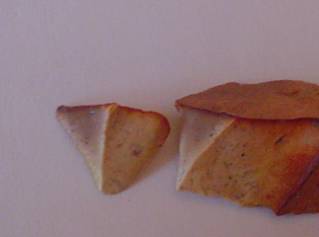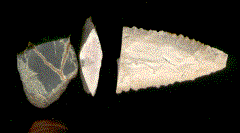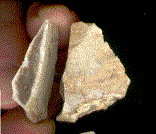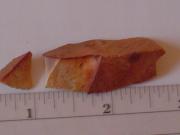|
FICK’S LAWS AND THE AGE OF STONE TOOLS By Rene M. Rogers
Abstract A new technique for directly measuring the age of ancient stone tools is suggested here. This technique, which is independent of the properties of the surroundings where the tools were discovered, takes into account the diffusion of trace elements and the effect this diffusion has on the color of the rock. If a rock has been broken, the trace elements near the exposed surfaces will, over time, escape into the external environment, with the result that the color of the exposed surface will differ from the color of the base. If such is the case, one could readily determine the time lapse involved if one knew the diffusion parameters of the material, the trace elements involved, and the average temperature over this time. If more that one trace element is involved, both time and the average temperature will be found over a narrow range. Fick’s Laws describe the diffusion of trace elements in liquids, solids, and gases. Based on the general observation that the atomic particles in most substances are always “on the move” in one way or another, these laws are identical in form to the more familiar heat equations that describe the diffusion of thermal energy whereby heat flows from hot regions to cooler regions in liquids, solids, and gases. In the case of solids, the vast majority of these
particles align themselves in crystal structures of a dozen or so
classifications, and materials scientists can study them by noting the
orderly ways in which they reflect X-Rays of the appropriate wavelength.
The individual atoms making up such a solid tend to vibrate
slightly about their home location and leave that location only on very
rare occasions. The thermal
energy associated with this motion, on average, is a measure of the
temperature of the solid. Most
solids will melt and become a liquid when the thermal energy of the
individual particles exceeds the binding energy at their permanent
locations. Most solids can
take on trace quantities of other atoms that tend to stay in a fixed
location for much shorter times, but they do tend to migrate throughout
the solid in a process called “diffusion,” as described by Fick’s
Laws. Liquids are characterized by a pronounced lack of any crystal structure such as we see in solids. The term “viscosity” is commonly used to characterize liquids and to distinguish them one from another. The viscosity of common liquids such as water can be measured by observing the relationship between mass flow rates and the pressure variation along certain flow paths like a round pipe. The flow of sewage into a treatment facility, for example, is quite accurately measured by observing the height of the stream behind a weir (a rectangular opening in a concrete barrier) at the entrance to the facility. The viscosity of common liquids varies greatly at the
range of temperatures where humans are more or less comfortable. Most
people have probably never thought of the glass bottles and jars they use
every day as liquids, but that is precisely what they are. At room temperature most of these items are extremely viscous
and have a number of the properties of a solid, but at elevated
temperatures the liquid properties become more and more apparent. When glass is broken at room temperature many of the
edges are very sharp indeed. The
stones that primitive people found most useful for making their everyday
tools such as knives and arrowheads are also predominantly glasses and
this tendency to form razor-sharp edges is very useful and of prime
importance to them as tools. It has also been noticed over the centuries that
man-made glass can be produced in a wide variety of colors by the addition
of small amounts of other substances, typically metals. Cobalt, for example, turns most glasses blue while chromium
tends to produce reds. There
was a time when the staining of glass was a closely guarded trade secret.
Some diffusion of the trace elements used to make stained glass
windows and other decorations in ancient holy places has been reported.
The sharp edges once used to portray the likeness of saints and
other holy figures have been observed to become slightly less sharp over
the ages. Let
us consider how these facts can be used to determine the age of stone
tools. Consider for example
the item shown below in Figure 1. The
triangular face is roughly ¼ inch on the sides.
Figure
1. The piece of stone
in Figure 1 is one of many similar items discovered at a site near
Gainesville, Florida. This
site is believed by some to have been a stone tool factory long before
Columbus’s voyages. This
site is located within a field measuring about 10 acres within which
hundreds of intact arrowheads, other stone items, and countless bits of
debris, such as this piece, have been found.
Similar fields in the general area have been gone over with great
care and have yielded nothing similar.
The surrounding region within a dozen or so miles is home to a
number of sinkholes, where large and small stones suitable for tool making
are to be found. There are
perhaps a half-dozen such known sites within a few miles of the city where
tools and debris can be found. A
large number of dugout canoes were unearthed a couple of years ago on the
muddy shores of a nearby lake following a severe drought, strongly
suggesting that aboriginal people used the region for some commercial
purposes. The ages of the canoes have been found precisely from the tree
rings, and it seems likely that human activity went on here soon after
people from Europe or Asia arrived. The stone shown in
Figure 1 was clamped in a soft vice and struck lightly by a small hammer
to expose the triangular surface shown at the end of the large piece.
It seems likely to this observer that what is seen here is a
classic example of the diffusion of trace elements in a glass.
Note that at the base of the exposed triangle there is a thin skin
of a coating that contains a reddish-brown pigment.
Thin skins of this sort are very common in sedimentary rock, or so
it seems from the common stones found in the sinkholes or any nearby creek
bottom. It seems likely that
the whole exposed surface was this darker color near the base of the
triangular surface when the piece was broken off the parent rock, perhaps
in the course of tool making. Then,
over several centuries, the trace elements near the exposed surfaces
escaped into the external environment.
If such a scenario is, in fact, the case we could readily determine
the time lapse involved if we knew the diffusion parameters of the glass
and the trace elements involved and the average temperature over this
time. The Handbook of
Chemistry and Physics devotes several pages to the numerical values of
the diffusion parameters of various trace elements in pure metals.
These were determined by observing the motion of radioactive tracer
elements in the solids involved over a range of temperatures.
In the case of metal trace elements diffusing in glass, there are
no examples given in the Handbook, but several methods of finding them
have been suggested to me. Dr.
Abraham Kaufman, a materials scientist and Laue X-Ray expert, has
suggested that using thin specimens of the glass with known trace elements
(mostly metals) and observing the absorption spectra of light as a
function of wavelength and temperature could be sufficient in many cases. At the atomic
level we can imagine a tracer particle, probably an atom or the nucleus of
an atom, trapped within the atomic structure of the glass or solid under
study. This particle is
moving about with random thermal energy as described by Boltzman
Statistics. The probability of escape at a trial is typically extremely
small, but the frequency of attempts is extremely high and
temperature-dependent. The
net result is that tracer particles eventually escape their surroundings,
only to be trapped in a similar situation, except in the case where the
trap is at the surface. In
this case there is a strong likelihood that the particle will escape
altogether. The diffusion parameters are 1) the probability of escape
from a trap in a given time lapse and 2) the distance to the next trap.
These parameters can be found in terms of the observed movement of
the tracers as a function of temperature. If the color
pattern observed is caused by a single type of trace element, then it will
be necessary to know the average temperature over time in order to
estimate the time lapse involved. But
if more than one type of tracer element with different diffusion
parameters is involved, it is very likely that only a narrow range of
average temperature and time lapse estimates will accommodate all of the
diffusion parameters. A variety of
common diffusion patterns are shown in Figure 2.
Such items are very plentiful, both the tools and the scraps left
over from tool making in a number of known sites.
The
basic central color of the arrowhead (at the left) is populated by a
number of tiny spots that may be the source of the basic color. I
am very grateful to Robert Kantor for his invaluable assistance with
regard to grammar and style in the preparation of this paper. Feb 5, 2012 edit.
|




